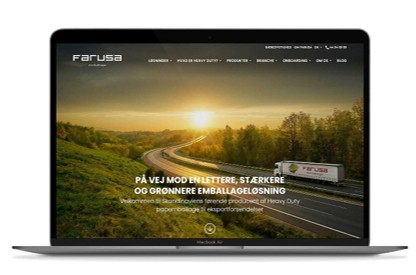PLANE:
If your customer requires a fast turnaround from order to delivery, air freight is often used. It’s an efficient method that can be executed very quickly.
Although there are restrictions on what you can ship—especially when considering air safety—there are very strict rules and definitions regarding what counts as dangerous goods.
If your export goods are not classified as dangerous, you’ll likely be charged based on two factors:
- Volume – how much space the product takes up in the cargo hold
- Weight – the total weight once everything is packed and ready
You might be thinking, “Sure, but we just pass that cost on to our customer.”
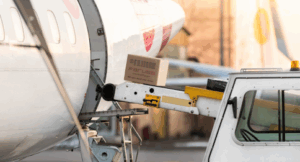
That may be true but consider how much you could improve your competitiveness with that customer, by optimizing and reducing the shipping costs you pass on.
This is where our packaging really shines. Our packaging can be customized to fit your product perfectly, eliminating wasted space and thereby optimizing the volume factor.
Similarly, our Heavy-Duty packaging (1200 x 800 x 600 mm) weighs significantly less than alternative packaging made from wood or plywood. So right from the export stage, you save money on air freight.
For comparison, 3 pallet frames weigh about 33 kg, assuming they are neither wet nor damp. Likewise, plywood boxes can be quite heavy (around 18 kg), while a FARUSA Heavy Duty package of the same dimensions, weighs approximately 9 kg.
Similarly, our Heavy-Duty packaging (1200 x 800 x 600 mm) weighs significantly less than alternative packaging made from wood or plywood. So right from the export stage, you save money on air freight.
For comparison, 3 pallet frames weigh about 33 kg, assuming they are neither wet nor damp. Likewise, plywood boxes can be quite heavy (around 18 kg), while a FARUSA Heavy Duty package of the same dimensions, weighs approximately 9 kg.
TRUCK:
The constant quest for space optimization happens on trucks. A typical truck has a limit of 32 EURO pallets, though you may be able to stack higher depending on your situation.
Most companies are willing to accept the longer transit times that come with trucking through European roads.
However, the new road tolls that freight companies have faced are being passed directly on to you as the consumer of the freight service. This increase has likely also been passed on by your company to your customers, which is why optimizing load space is more important than ever before.
Transportation is no longer a minor factor; it now takes up a significant part of most companies’ export budgets.
That’s why we’re happy to help you optimize your purchases with us, we always advise you on the quantities that make the most sense to order to maximize the efficiency of your freight.
One of FARUSA’s core services is safety. This becomes especially important if you plan to stack your goods in a truck. You might wonder, “Why am I offered such high-quality packaging?”
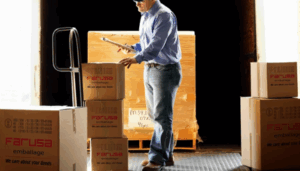
It’s precisely because the weight distribution changes during road transport. When you stack something on top of something else, it’s usually not a problem on a stable floor that doesn’t move, but in the back of a truck, the pressure on the bottom pallet changes significantly.
The packaging must withstand and hold up so that your product arrives safely. We calculate that safety factor for you, and it’s already built into the quality we offer.
That said, road transport is almost always part of the export journey, after all, your goods probably won’t fly to the port or airport on their own.
SHIP:
If you ship by sea, you can find inspiration in our blog post “Are You Getting the Most Out of Your Export” where we use visuals to show the limitations and possibilities you have when using a shipping container.
A container shares many of the same limitations as a truck when it comes to dimensions. There’s only so much you can “squeeze in” in terms of height and width.
That’s exactly why it’s essential for cost-efficiency, optimization, and especially from a sustainability perspective, to make the most of the available space.
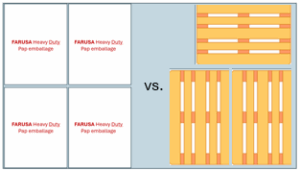
The stacking concept is the same as with trucks, but the harshest environment you can expose your export goods to is sea transport. That’s primarily due to the shifting wave directions, that the ship encounters at sea. The pressure this creates inside a container could crush even the boldest dreams, except, of course when it comes to our packaging.
And let’s not forget the climate inside a shipping container.
The ship passes through many different external environments, where daytime temperatures can easily reach +35°C, and nighttime temperatures can drop to –10°C—all while sailing on the same ocean.
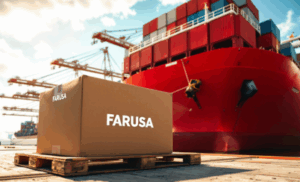
External temperatures naturally affect the internal climate, and the packaging inside the container will be exposed to the same temperature fluctuations as the outside environment. But there’s one crucial factor to keep in mind when it comes to the internal climate, moisture.
With such drastic temperature shifts, moisture becomes a major factor inside a container. Your packaging must be able to withstand it, to protect your goods.
FARUSA’s Heavy Duty packaging is weather-resistant. That means it resists moisture while maintaining its strength and stacking capacity, even during the long journey in a shipping container, which is far from a first-class cruise to the Caribbean.
In short, whether you ship by air, road, or sea—we take responsibility for ensuring your goods are well protected, can withstand harsh environments, and handle the significant pressure they’re exposed to.
Whether you stack 1:1 or 2:1, regardless of the mode of transport, we do the calculations for you, and you’ll clearly see the result in the quality we provide.
Scan the QR and find your advisor

